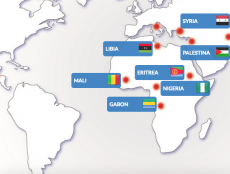
Articles
Editor’s Picks
Higher Education
K-12
Free OER Platforms: Everything You Need to Know
By Henry Kronk
September 18, 2019
Educators and students have found a few reasons to grow frustrated with the textbook market in recent years. That has led many to seek out alternatives with open educational resources (OER). OER material tends to be released under a Creative Commons license, making it freely available for use by educators. Most OER can be downloaded, republished, edited, and customized. So much OER has circulated in recent years that some companies have even developed business models around packaging, delivering, and supplementing this open course material. This article instead goes over what is available and what is currently possible with free OER platforms.
Finding OER
One of the main difficulties educators experience with implementing OER is that there is a lot of it, and it is spread widely throughout the internet. It might not be vetted, updated, or accurate. Most sites and services tend to focus on higher education, but some free OER platforms, like LearnCloud and, to a lesser extent, the Smithsonian Learning Lab, target K-12 education.
Many institutions of higher education have created their own OER platforms or libraries. For example, the State University of New York (SUNY) system has developed Open SUNY. The platform, like many others created by institutions themselves, has made its library open to the public, but only accepts OER submissions from SUNY faculty.
The largest, most comprehensive free OER platform appears to be OER Commons. It has partnered with numerous OER initiatives (including those run by SUNY, UNESCO, and the state of Maryland), and offers collections in collaboration with groups like the Folger Shakespeare Library and Carnegie Hall’s Weil Music Institute. The site also records a title’s upload date and provider.
Other free OER platforms, like OpenStax, offer a much more limited catalogue of titles. But in exchange for quantity, OpenStax provides a higher quality of OER with its official catalogue. The platform puts each title through a peer review process, and also offers a much more interactive user experience. OpenStax began as an initiative at Rice University way back in 1999.
Similarly, the offerings from Wikibooks are actively updated by a team of volunteers like other articles throughout Wikipedia.
Many platforms also package OER material together. The Community College Consortium for Open Educational Resources, for example, bundles entire degrees-worth of OER together.
There are likely millions of OER titles available across the internet, and finding the right one can be the most difficult process in implementing OER in the classroom.
Customizing OER
Many instructors might find great OER material, but still want to tweak, add, or subtract a few things for their own purposes.
Creative Commons, the organization that administers the Creative Common open copyright licenses, defines OER as “teaching, learning and research materials in any medium that reside in the public domain or have been released under an open license that permits no-cost access, adaptation and redistribution by others.”
By that definition, all OER is customizable. Creative Commons does, however, offer numerous types of open licenses. CC BY-ND, for example, permits others to share and distribute the work in question, but does not allow it to be changed or customized. It’s possible, therefore, that certain materials might be shareable and re-printable, but not customizable.
When it comes to customizing OER, most free platforms provide the tools to do so. There are also tools that exist independently of OER libraries and catalogues that provide the tools necessary to make changes.
OERPub, for example, has partnered with Github to offer fairly comprehensive OER editing tools. One can use the platform to import existing OER to edit and remix as one sees fit.
Authoring OER
Like customizing, many free OER platforms also allow for individuals to author their own open materials from scratch. OER Commons is a good place to start with this. Not every platform, however, will necessarily be willing to host one’s OER. As mentioned above, many institutional platforms only accept OER authored by their own faculty. Similarly, while one can author OER with OpenStax, one’s finished product likely will not join the official catalogue. OpenStax’s Anthony Palmiotto provides a guide for authors using the platform to publish their OER elsewhere.
Beyond Free OER Platforms
Many for-profit companies also work with OER. That might sound like an oxymoron. These platforms, however, build services on top of existing OER. They might include aspects typically provided by learning management systems, like discussion forums, multimedia sharing, or grading features. Some also offer sleeker and slicker design authoring features and more interactive UX features. Others still have employed AI components to take OER and create course supplements, like homework and quizzes, that align directly with the materials being used.
Companies like TopHat, panOpen, Lumen Learning and more offer services like these—for a price. Still, universities who have grown sympathetic to the OER movement have increasingly chosen these services as a means to save students money while making it easier for professors to adopt OER.
Featured Image: Alex Holyoake, Unsplash.









4 Comments